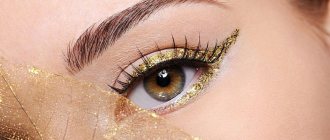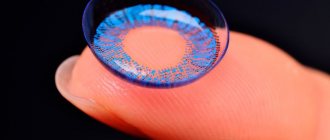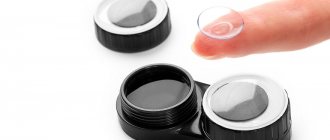The modern ophthalmological market offers a varied palette of cosmetic lenses. When choosing a product, it is important to consider several points that will allow you not to be disappointed by the effect of color optics.
Appearance is very important for every girl. Everyone strives to be irresistible not only at special moments, but every day. Today, colored contact lenses help you create your own individual image. The wealth of colors and shades allows you to choose optical products to suit every taste. Those with green eyes can also highlight their brightness and add depth or completely change the color.
What are colored lenses
But don’t be afraid of this, because women of the 21st century are lucky, and they can even modify their body completely, and changing eye color is not the most surprising and expensive thing on the list of such modifications. Today, changing your eye color is much easier than changing your hair color. Contact lenses for vision correction are familiar to almost everyone, and they are an excellent alternative to glasses for daily wear. There are a lot of advantages to wearing them:
- invisible to others;
- do not cause discomfort;
- do not fog up;
- don't fight;
- you can swim in them.
There are significantly fewer disadvantages. This is the need to periodically buy new ones and the fact that they need to be removed and cared for every evening. Initially, contact lenses were invented only for correction and did not affect the shade of the eyes in any way. But then the manufacturers realized that they could “kill two birds with one stone”: allow a person to see better and change the color of his eyes. And later they began to produce lenses that do not affect vision in any way and are made solely to change the color of the iris of the eyes.
Today there are dozens and even hundreds of shades available. You can make your natural shade slightly brighter, or you can change the color radically. If you want bright eyes, then the best choice is blue or green contact lenses. You can buy several different shades of lenses and match them to your mood and clothing. But you need to remember that wearing them for longer than 8 hours is not recommended, since they allow less air to pass through than transparent ones.
Types of colored contact lenses
To choose lenses for green eyes, you first need to decide what effect you want to achieve. There are three types of colored eye lenses:
- Cosmetic. They radically change the eyes, completely covering the iris. Such optical products are suitable for owners of both light and dark eyes.
- Tinted. Such products contain a less saturated coloring pigment. They enhance the natural shade, giving the native eye color depth and shine.
- Carnival. Models of this type come in various designs and patterns. They are not intended to be worn constantly. They are used during themed parties, photo shoots or worn to a nightclub.
Depending on the purpose, you should choose one of the listed types.
Contact lenses with coloring pigment can also perform a purely aesthetic function, or serve for vision correction. Thus, there are two types of products:
- with diopters (not only change eye color, but also improve vision);
- without diopters (such products are called decorative or cosmetic; they are used only to change the natural color of the eyes).
Different types of contact optics are also manufactured in different ways. Colored eye lenses consist of several layers. The coloring pigment in them is in the middle. It does not come into contact with the membrane of the eye and is completely safe for the organs of vision. The pupil area remains unpainted. Due to this, colored lenses do not interfere with clear vision. The uncolored part is larger than the pupil itself, since it does not have a constant diameter. Its size increases in low light and decreases in bright light.
Contact lenses with pigment are:
- plain;
- two-tone;
- three-tone.
In monochromatic models, the colored part creates the effect of the iris. This look does not completely change the natural color of the eyes. It is designed to highlight natural shade. A thin darkened rim is applied along the edge of the monochromatic lens. Its purpose is to add contrast to light eyes. Blue, cyan, green, turquoise, and gray lenses are made in this way.
Dual-tone lenses have a more saturated color. Typically, their manufacturing technology involves dividing one color into two tones, usually light and dark. When one is superimposed on the other, the pattern of the iris is simulated. The edge of the product is also darkened. Two-tone models completely change the color of the eyes. They are suitable for both girls with light eyes and those with dark eyes. The color range of two-tone contact products is very diverse. Each color has several shades, so by carefully reading the description, you can choose exactly the one that will best suit you.
Three-tone contact lenses have the most complex pattern. Their manufacturing technology involves mixing shades of natural pigments to achieve the maximum effect of naturalness. The distribution of coloring matter goes from light to dark, from the center to the edges. This is exactly what the coloring pigment looks like in our eyes. The edges of the three-tone models are highlighted with a dark rim. Similar to the natural color of the eye, this species has a complex iris pattern that changes color depending on the light. Three-tone models have a wide color palette. Different manufacturers offer blue, dark blue, brown, gray lenses and others.
What can you change besides color?
Lens production technology does not stand still. They are becoming thinner and more comfortable to wear. And also the designs of colored lenses do not stand still. Now you can change not only the color, but also the pattern of the iris, the size and shape of the pupil, and even change the color of the white of the eye, for example, to black or red. Many of these options are only suitable for themed parties, but some are suitable for everyday wear and can even change a person’s appearance. If you increase the size of the iris, the eye will visually appear larger and more rounded. And if you make the outer rim darker, your eyes will immediately become brighter.
What types of lenses are there for green eyes?
Let's start with the fact that colored lenses for eyes, familiar to us, come in two types. The first is not particularly bright coloring pigment and, as a rule, is not capable of providing dramatic changes. Such models are designed to simply enhance the natural shade, giving it richness, expressiveness to the eyes, and depth to the gaze. As you might have guessed, such optical products are called tint. The second type is directly colored contact lenses. Such models are more bright. They can change any shade, even a dark shade, such as brown. As a rule, when creating them, manufacturers strive to make the coloring pigment as dense as possible in its structure. This allows you to completely cover the natural tone. In addition, many modern companies specializing in the production of colored lenses resort to the use of unique technologies that allow them to imitate the natural pattern of the iris by applying a special pattern.
Is it easy to change the color radically?
If your eye color is gray or light green, then blue lenses will fit perfectly and it will be unnoticeable that the color is not your native one. Another thing is how blue lenses look on brown eyes, and in the vast expanses of the former CIS, people are more likely to see just such lenses.
The catch is that it is impossible to apply dye in place of the pupil itself, otherwise the person will not be able to see in such lenses. Often in photos, blue lenses on brown eyes look bright and organic. But in life, when the eye moves, its native color will slip around the pupil. And if the difference between your color and the color of the lenses is so radical, as with blue lenses on brown eyes, then in life it becomes visible to the naked eye. Blue and brown colors are the most incompatible with each other. That's why the contrast is so pronounced. Most shades of green and brown combine harmoniously, and the difference between them will be less obvious. Theoretically, it would be possible to make the diameter of the transparent space for the pupil narrower, but this will worsen vision.
"Trying on" colors
You can determine which lenses are right for you using a computer program. Now there are many simple applications, including on phones, that will allow you to experiment with your appearance on the screen. You can try on lenses in green shades or, for example, gray lenses. But this way you can only see what eye color suits you. At the same time, you need to understand that no program will show what the effect of optical products will be. For example, you can “try on” gray lenses and admire the result. But when you purchase gray lenses, you will see a completely different picture in the mirror. The gray color of the lenses, if it turns out to be too light, will not cover the natural pigment and you will be disappointed with the effect.
Are all lenses equally visible?
Having once seen a brown-eyed girl wearing cheap blue lenses with a flat color and was horrified by this, you should not give up on the idea of wearing blue lenses. The contact lens manufacturing industry is actively developing over time. The way blue lenses look on brown eyes depends on their quality and the correct selection. Today, manufacturers offer many models and colors. And you can choose ones that will look natural, without the terrible brown pupil slipping during rotation. And reviews of blue lenses on brown eyes vary from admiring to scolding.
How to cover up brown eyes with blue ones
It is quite possible for a brown-eyed girl to be blue-eyed and not make people laugh. You just need to choose the right blue lenses to cover your brown eyes. And there are three secrets here.
The first thing to pay attention to is the iris pattern. If you look closely at your eye, you can see that its color is not uniform. This is a combination of many shades that are intertwined with each other in a beautiful pattern drawn by nature itself. Thanks to this, the eyes look alive and radiant. Good colored lenses should have a pattern that cleverly imitates a natural one. And the better it is done, the more natural the lenses will look. For brown eyes, it makes sense to look for colored lenses that have brown veins interspersed with the correct shade of blue. The veins of dark blue closer to blue, interspersed with gray, also look harmonious.
What does correct blue mean? This is the second important point when choosing blue lenses for brown eyes. Anyone who is at least a little familiar with the artistic craft knows that there are dozens of shades of the same color, and they also have a temperature. Brown is almost always a warm color, but blue can be warm, like the color of the sea, and cold, like the color of ancient Arctic ice. So, brown-eyed people need to find lenses in a warm shade of blue.
And the third important secret when choosing colored blue lenses for brown eyes is that in addition to the outer dark ring, the lenses have an inner one. It should be a dark shade, close to black, and have soft borders. Then the movement of the pupil will be within this ring and will become invisible to others.
In order for the border between dark brown and blue to look harmonious, it is necessary that the lenses are not a solid color, but have a three-dimensional pattern. And the ring around the iris itself should be dark in color, and at the very border with the blue color it should turn into vague warm-golden colors. Such a rim will allow you not to see the border when moving the pupil. Here's how blue lenses can look perfect on brown eyes. There may be several options for such solutions, and you just need to choose the one that is best suited in a particular case.
How to choose your lenses
If corrective lenses are required, their selection should only be made by an ophthalmologist using specialized equipment. It is necessary to find out what specific visual defects the patient has. For some types of defects, such as astigmatism, lenses must be made to order. In this case, not every manufacturer of colored lenses does this. Therefore, for these patients, purchasing colored lenses can be a problem. If the defect is common, such as nearsightedness or farsightedness, then such lenses are mass produced and already coated with color.
Variety of green shades
With the help of green lenses you can give your eyes an unusual shade. The most popular colors are:
- emerald;
- azure;
- turquoise;
- grey-green;
- olive;
- swampy
Everyone chooses a color based on their preferences. Some people like a soft turquoise tone, others prefer a rich swamp shade.
Colored lenses for astigmatism
Astigmatism is a vision defect in which a person sees blurred due to the irregular shape of the lens. It can be either congenital or acquired due to injury. Determining astigmatism is more difficult than farsightedness and nearsightedness. In determining the degree of astigmatism, instruments such as a keratometer and a keratoscope are indispensable.
Patients suffering from astigmatism need rigid lenses, only they can keep the lens in the correct position. Soft ones would quickly adapt to the irregular shape of the surface of the eye and cease to perform their function. There are hundreds of options for exactly how the lens can be deformed, and therefore such lenses are always made to order.
Only a limited number of astigmatic lens manufacturers produce color coated lenses. But this is not bad, because a few years ago astigmatists could only be offered glasses to correct their vision. The price of such lenses will always be one third higher due to the uniqueness and complexity of the work. Astigmatism can be corrected permanently with laser correction. Treatment of one eye will cost at least 30 thousand rubles.
Leaders in the production of colored lenses
One of the main tips when purchasing lenses is not to buy them from unverified manufacturers. You should not skimp on things that concern such a sensitive organ as the eye. At best, you can get an allergy, and at worst, you can lose your sight. A guarantee that the lenses are of high quality is the fact that they are sold in trusted optics and have the necessary certificates. The leaders in the production of colored lenses are the following manufacturers:
- Alcon;
- Johnson & Johnson;
- Bausch&Lomb;
- CIBA Vision;
- Carl Zeiss;
- Bescon;
- OK Vision.
There are other young lens companies that are not yet household names, but have already won the trust of new users.
How to care and store
If these are not daily lenses, then every evening they should be removed before removing makeup with clean and dry hands with neatly trimmed nails. After this, they need to be washed with a special solution for storing lenses and placed in a special container with a clean solution, each in its own compartment, without getting confused. This must be done every day without exception, otherwise you can get an infection in the eye. You need to have plastic tweezers with silicone tips in a separate container to remove the lenses in the morning. If you use your fingernails, you may tear or scratch the lenses.
More thorough cleaning should be carried out at least once a month or as recommended by the manufacturer. It is produced using enzyme solutions or tablets.
Those who use daily lenses don't need anything other than tweezers. Every morning they take a new pair out of a new disposable container of clean solution and throw them away in the evening.
Rules for wearing and care
In order not to harm your eyes, lens optics should be worn correctly and cared for properly. First of all, many ophthalmologists do not recommend such optics for children under 10 years of age. This is due to the fact that at this time the visual organs are actively developing and a foreign body on the mucous membrane can disrupt this process.
How to wear it correctly
You cannot wear colored lenses 24/7. Ophthalmologists recommend wearing them for 6–8 hours and then removing them. If this type of optics is purchased for the first time, then it is better to give preference to products that can be worn for a day. If a person has already decided on a shade and the lenses suit him completely, then he can switch to reusable products. They are more favorable in terms of price-quality ratio.
Before putting on the scope, you should wash your hands thoroughly. After this, the product is taken out of the container and placed on the index finger. Then, with two fingers of one hand, carefully spread the eyelids and place the lens on the mucous membrane.











